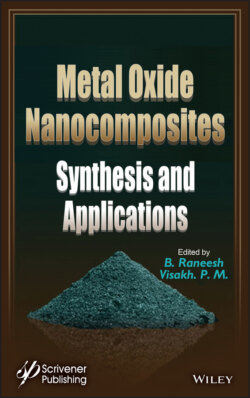Читать книгу Metal Oxide Nanocomposites - Группа авторов - Страница 20
1.8 Applications of Metal Oxide-Based Nanocomposites
ОглавлениеMetal oxide nanocomposites of ZnO, CeO and CuO used as slow and controlled release of fertilizers provide nutrients to plants for prolonged period and also helps in prevent of soil degradation and improvement of sustainable agriculture [141, 142]. Nasiri et al. [143] discussed with enhanced oxygen barrier properties, and their application as packaging. LDPE films-based TiO2 nanocomposites have been reported to preserve other foods including strawberries, cheese, and shrimp [144, 145]. Cerrada et al. [146] prepared TiO2 nanoparticles based ethylene–vinyl alcohol (EVOH) nanocomposites. This nanocomposites with self-sterilizing properties and showing effectiveness against Gram-positive and Gram-negative bacteria. The starch/iron oxide nanocomposites for MRI and drug delivery applications [147, 148], chitosan/CuO nanocomposites are using as photocatalyst and antibacterial agent [149], epoxy/ZnO nanocomposites for light-emitting diodes based applications [150] and PMMA/ZnO nanocomposites using for Memory cells [151]. Skorenko et al. [152] have been prepared ZnO–chromophore nanocomposite, these nanocomposites demonstrates a thermal stability up to 300 °C. ZnO by a polar covalent metal-to-chromophore bridge which minimizes thermal degradation pathways of the organic molecules. Jo et al. [153] prepared an ultrafiltration membrane of poly(1-vinylpyrrolidone-co-acrylonitrile)-g-ZnO and poly(ether sulfone)-g-ZnO with both membranes have high antibacterial performances and both membranes show improved water flux, high antibacterial activities, and antifouling characteristic. The hybrid reverse osmosis membranes nanocomposite [154] of aromatic polyamide thin films and TiO2 particles were prepared through a self-assembly route, this membrane irradiated UV light showed enhanced photocatalytic bactericidal efficiency. Polymer nanoocomposites with TiO2 effectively degrade contaminants in water, for example chlorinated compounds in the water [155].
Teli et al. [156] have synthesized polyaniline-based TiO2 metal oxide nanocomposites. This nanocomposites were synthesized using the in situ polymerization to enhance the property of membrane antifouling. A hybrid SiO2/polyvinylchloride nanocomposites was prepared using the phase-inversion technique [157]. This nanocomposites shows better performance toward bacterial attachment and protein absorption, higher flux recovery ratio, and better antifouling performance compared to the neat polyvinylchloride. Feng et al. [158] have been synthesized many metal oxide based nanocomposites such as acetate/polypyrrole/TiO2, succinic-polypyrrole/TiO2, tartaric/polypyrrole/TiO2 and citric/polypyrrole/TiO2 and the results was excellent, the hydroxyl group significantly influenced the adsorption capacity and the better physicochemical properties of the nanocomposite were occurred. The electrical properties of polymer nanocomposites depends their nanoparticles size are in nano scale for many reasons. Anand et al. [159] have been synthesized Graphene/zinc oxide (ZnO) nanocomposite by in situ reduction of zinc acetate and graphene oxide (GO) during refluxing, structural, morphological and elemental analysis, the synthesized samples were characterized by X-ray diffraction, field emission scanning electron microscopy, X-ray analysis (EDX) and Fourier transform infrared spectroscopy. Several metal oxide nanoparticles and their composites have been widely used for the wastewater treatment by adsorptive removal and the photocatalytic degradation [160].
In the field of energy harvesting applications, nanogenerators (NG) have resulted a revolution [161]. The first NG was introduced by Wang and his group in 2006, which successfully used AFM tip to harvest mechanical energy by deflecting mechanism of ZnO nanowires in contact mode [162].
